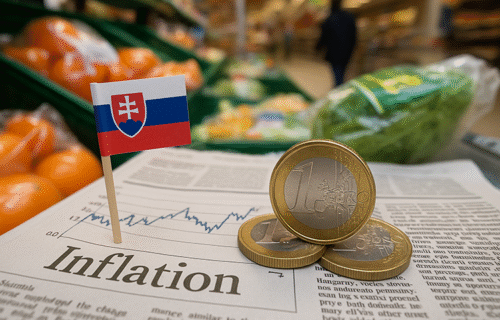Consumer prices in Slovakia rose at a faster pace in September, with harmonised inflation reaching 4.6% year-on-year, according to new data from the Statistical Office of the Slovak Republic. The reading, which follows the European Union’s harmonised methodology (HICP), was slightly higher than the national index released earlier this week, which recorded 4.3%.
Month-on-month, prices grew by 0.2%, marking the third consecutive monthly increase. The acceleration was driven primarily by higher costs in education, restaurants and hotels, and miscellaneous goods and services, while food and non-alcoholic beverage prices eased by 0.3%, reflecting seasonal declines after the summer harvest.
Among key sectors, education showed the sharpest rise, up 3.7% compared to August and 9.8% higher year-on-year. The Statistical Office noted that price increases were recorded in eight of the twelve expenditure divisions tracked, with only food, transport, and communication seeing mild monthly decreases.
The average annual HICP inflation rate — measured across the period from October 2024 to September 2025 — stood at 4.1%, continuing a gradual cooling trend after double-digit levels seen in 2022 and 2023.
Although inflation remains above the Eurozone average of 2.8%, Slovakia’s position has improved compared to previous years, when surging energy costs and imported inflation heavily affected household budgets.
According to Eurostat’s comparative data, Slovakia’s September figure places it slightly above neighbouring Czechia (3.3%) and Poland (3.8%), but below Hungary (5.2%), reflecting a broadly stabilising pattern across Central Europe.
From a methodological standpoint, Slovakia continues to modernise its inflation reporting. Since early 2024, the Statistical Office has replaced traditional field surveys for food prices with scanner data from retail transactions, expanding the change to alcoholic beverages and tobacco from January 2025. The move aligns with Eurostat’s push to improve the precision and timeliness of consumer price statistics across the EU.
Economists say the latest figures suggest the composition of inflation in Slovakia is shifting. Energy and goods prices have largely stabilised, but services and education now account for much of the price pressure. “The pattern of inflation is becoming more domestic in nature,” said one Bratislava-based analyst. “It’s being driven by wage growth and the cost of services rather than external shocks.”
The Statistical Office will release a full breakdown of price contributions later this month, while Eurostat is set to publish EU-wide harmonised data today, offering a comparative view of inflation dynamics across member states.
Source: Statistical Office of the Slovak Republic, Eurostat, CIJ EUROPE analysis.
